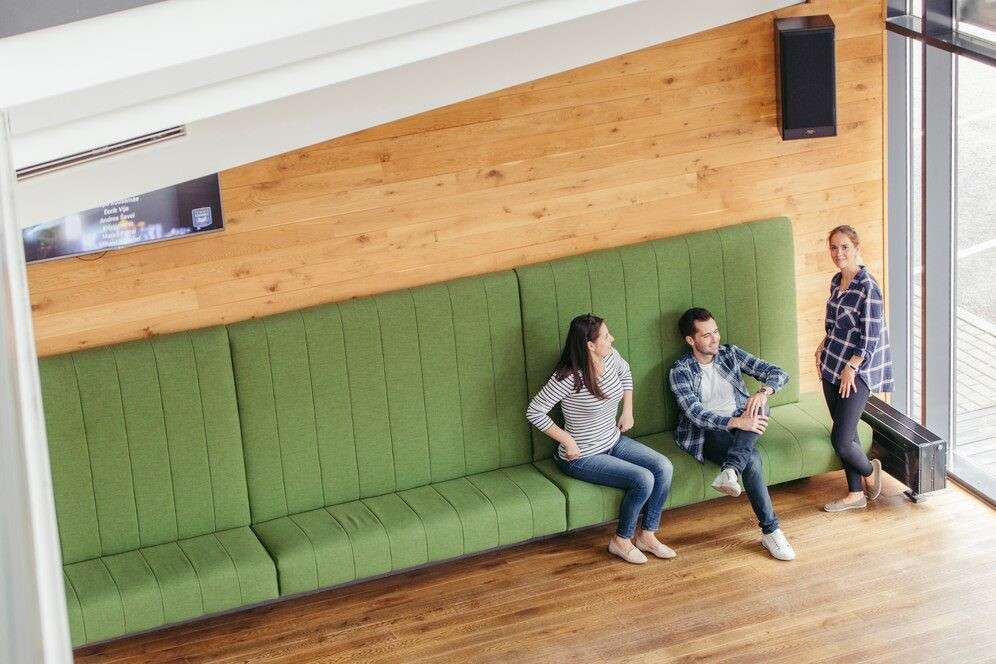Ergonomic Office Furniture for Waiting Rooms: What You Need to Know

Ergonomics in waiting rooms shape the client experience, which is crucial nowadays, especially as the furniture market is projected to reach 1.5 billion users by 2029. Comfortable, well-designed waiting room furniture not only enhances physical comfort but also reflects professionalism and attention to detail.
When clients sit in ergonomic reception chairs or modern waiting room furnishings that provide proper support, they feel more relaxed and valued, which positively impacts their perception of the business.
Here are five key reasons why ergonomic design in waiting rooms matters.
Table of Contents
Key Takeaways✔ Ergonomic reception chairs with proper lumbar support improve client comfort and reduce back strain. ✔ Mixing seating options like heavy-duty waiting room chairs and modular sofas accommodates different client needs. ✔ Accessible seating arrangements with wide, reinforced chairs promote inclusivity and comfort for all clients. ✔ Modern waiting room furnishings create a professional image and improve first impressions. ✔ Durable materials and reinforced frames in commercial waiting room chairs reduce long-term maintenance costs. ✔ Regular cleaning and rotating of waiting room furniture prevent wear and maintain a fresh appearance. ✔ Thoughtful furniture placement with clear walkways and balanced seating improves flow and client comfort. |

1. Enhances Client Comfort
Comfort is essential in any waiting area, especially when clients need to sit for long periods. Well-designed waiting room furniture can significantly improve the client experience by reducing physical discomfort and creating a welcoming atmosphere. Investing in ergonomic reception chairs ensures that clients feel at ease while waiting.
How Ergonomic Design Improves Comfort
- Proper Lumbar Support: Ergonomic reception chairs with built-in lumbar support help maintain the natural curve of the spine, reducing strain on the lower back. This prevents discomfort and stiffness, especially during long wait times.
- Balanced Seat Height and Depth: Commercial waiting room chairs with adjustable seat height and depth ensure that clients’ feet rest flat on the floor while their knees are at a comfortable angle. This promotes better circulation and reduces pressure on the legs.
- Cushioning and Padding: High-density foam padding in heavy-duty waiting room chairs provides both softness and support. This type of padding reduces pressure points and helps maintain comfort even during extended periods of sitting.
2. Promotes Better Posture
Good posture is essential for long-term comfort and overall well-being. Poorly designed waiting room furniture can cause slouching, back pain, and muscle strain, leading to discomfort and fatigue. Ergonomic reception chairs encourage proper posture by providing structured support that aligns the body correctly.
How Ergonomic Design Promotes Better Posture
- Contoured Backrests: Ergonomic reception chairs with contoured backrests support the natural curve of the spine, encouraging a neutral sitting position. This reduces strain on the lower back and helps prevent slouching, even when seated for long periods.
- Seat Angle and Tilt: Modern waiting room furnishings with adjustable seat angles allow clients to position their hips and knees at a comfortable angle. A slightly forward seat tilt promotes a more active sitting position, reducing pressure on the lower back.
- Armrest Height and Positioning: Properly positioned armrests on commercial waiting room chairs support the shoulders and arms, reducing tension in the neck and upper back. Armrests at the right height also make it easier for clients to sit down and stand up without straining their muscles.
3. Increases Accessibility and Inclusivity
Not all clients have the same physical needs, so waiting room furniture must accommodate a wide range of body types and mobility levels. Heavy-duty waiting room chairs and modular seating options ensure that all clients, including those with limited mobility, feel comfortable and supported. Accessible seating promotes inclusivity and creates a welcoming environment.
How Ergonomic Design Increases Accessibility and Inclusivity
- Wide and Reinforced Seating: Heavy-duty waiting room chairs with wider seats and reinforced frames provide extra stability and support. These chairs accommodate higher weight capacities, ensuring that all clients feel secure and comfortable.
- Lower and Higher Seat Options: Offering a mix of low and high seating options helps clients with different mobility levels sit and stand with ease. Lower seats make it easier for shorter individuals to rest their feet flat on the floor, while higher seats assist those with joint or mobility issues.
- ADA-Compliant Seating: Commercial waiting room chairs designed to meet ADA (Americans with Disabilities Act) guidelines ensure that clients with mobility aids, such as wheelchairs and walkers, can easily access and use the seating. This helps create an environment where all clients feel valued and accommodated.
4. Enhances Professional Image and First Impressions
A waiting room is often the first point of contact between a business and its clients. Modern waiting room furnishings that combine style with comfort create a positive first impression and reflect the company’s professionalism. Investing in high-quality ergonomic reception chairs signals that the business values client comfort and takes pride in its appearance.
How Ergonomic Design Enhances Professional Image
- Consistent Style and Branding: Modern waiting room furnishings that match the company’s color scheme and design aesthetic create a cohesive, polished look. Coordinating commercial waiting room chairs with the overall décor reinforces the brand’s identity and professionalism.
- High-Quality Materials and Finishes: Heavy-duty waiting room chairs made with premium fabrics and reinforced frames project a sense of quality and durability. Clean lines and contemporary designs give the space a modern, upscale feel.
- Organized Seating Layout: An ergonomic and well-planned seating arrangement prevents overcrowding and creates a sense of order. Arranging waiting room furniture with adequate spacing improves traffic flow and helps clients feel more relaxed and comfortable.
5. Reduces Long-Term Costs and Maintenance
Investing in ergonomic waiting room furniture isn’t just about client comfort—it’s also a smart financial decision. Heavy-duty waiting room chairs and commercial seating options are built to withstand constant use, reducing the need for frequent repairs and replacements. Durable materials and ergonomic designs contribute to long-term savings and fewer maintenance issues.
How Ergonomic Design Reduces Long-Term Costs
- High-Durability Materials: Commercial waiting room chairs made with reinforced steel or solid wood frames resist wear and tear from daily use. High-performance upholstery materials, such as vinyl and stain-resistant fabrics, maintain their appearance even after years of heavy traffic.
- Easy Maintenance and Cleaning: Modern waiting room furnishings with non-porous surfaces and removable covers make cleaning quick and hassle-free. Stain-resistant fabrics and water-repellent finishes protect against spills and damage, extending the life of the furniture.
- Longer Product Lifespan: Heavy-duty waiting room chairs with reinforced joints and high-density foam maintain their shape and support over time. Investing in ergonomic reception chairs designed for long-term use reduces replacement costs and ensures consistent client comfort.
How to Arrange Waiting Room Furniture for Better Flow and Comfort
The layout of a waiting room plays a major role in shaping the overall client experience. A well-organized space with thoughtfully arranged waiting room furniture not only improves comfort but also enhances the room’s visual appeal and functionality. Creating a balanced, inviting space requires careful consideration of seating placement, traffic flow, and overall design.
1. Create Clear Walkways and Traffic Flow
A waiting room should have enough open space for clients to move around comfortably without bumping into furniture. Commercial waiting room chairs should be positioned at least 3 to 4 feet apart to allow for easy movement and accommodate clients with mobility aids. Keeping walkways clear also improves safety by reducing the risk of trips and falls.
2. Use a Mix of Seating Options
Incorporating a variety of seating styles ensures that different client needs are met, aligning with the projected 7% annual growth of the global ergonomic chair market from 2023 to 2030. Heavy-duty waiting room chairs are ideal for clients who need extra support, while modular seating allows for flexible arrangements. Mixing different types of seating creates a balanced, inviting space that feels intentional rather than cluttered.
3. Position Furniture to Encourage Social or Private Seating
Arranging waiting room furniture in clusters creates both social and private seating areas. Grouping ergonomic reception chairs together with a small table in between encourages conversation, while positioning some chairs against the walls provides a more private option. This balance ensures that clients have the choice to engage or sit quietly while waiting.
4. Keep the Reception Desk in View
Positioning waiting room furniture so that the reception desk is easily visible helps clients feel more comfortable and secure. Commercial waiting room chairs should face the reception area whenever possible to allow clients to see staff and approach them with questions. This setup also improves the receptionist’s ability to monitor the room and address client needs promptly.
5. Ensure Even Spacing and Symmetry
Even spacing between waiting room furniture creates a clean, organized look that feels intentional. Symmetry helps balance the visual flow of the room, making it more inviting. For example, placing heavy-duty waiting room chairs on either side of a central table or along a wall creates a cohesive and balanced seating arrangement.
6. Leave Open Spaces for Wheelchairs and Mobility Aids
ADA compliance requires that waiting rooms include open spaces to accommodate clients with wheelchairs or walkers. Heavy-duty waiting room chairs with reinforced frames should be positioned next to open spaces to ensure that clients with mobility aids have easy access. Leaving these spaces open also improves overall traffic flow and ensures that everyone feels welcome and comfortable.
How to Maintain and Clean Commercial Waiting Room Chairs
Keeping commercial waiting room chairs clean and well-maintained is essential for preserving their appearance and ensuring long-term comfort. Waiting room furniture endures constant use, so regular cleaning and maintenance help extend its lifespan and keep it looking professional. Proper care also ensures that modern waiting room furnishings remain comfortable and visually appealing for clients.
1. Establish a Regular Cleaning Schedule
Regular cleaning prevents dirt, dust, and stains from building up on waiting room furniture. Commercial waiting room chairs should be vacuumed or wiped down at least once a week, depending on the level of foot traffic. High-traffic waiting rooms may require daily touch-ups to maintain a clean and inviting appearance.
2. Use the Right Cleaning Products for Upholstery
Different materials require different cleaning solutions to avoid damage. For fabric ergonomic reception chairs, use a mild detergent mixed with water, and avoid harsh chemicals that can weaken fibers. For leather or vinyl chairs, a gentle leather cleaner or a damp microfiber cloth helps maintain the material’s texture and sheen.
3. Spot Clean Stains Immediately
Spills and stains should be addressed right away to prevent permanent damage. For fabric commercial waiting room chairs, blot (don’t rub) the stain with a clean cloth and use a mild cleaning solution if needed. For vinyl and leather waiting room furniture, wiping the area with a damp cloth usually removes most stains without damaging the material.
4. Inspect for Structural Damage
Regularly check for loose screws, weakened joints, and worn-out padding in heavy-duty waiting room chairs. Tightening bolts and reinforcing seams helps prevent more extensive damage over time. Addressing small issues early extends the lifespan of waiting room furniture and prevents costly repairs.
5. Protect Chairs from Direct Sunlight
Prolonged exposure to direct sunlight can cause fabrics and leather to fade and deteriorate. Position modern waiting room furnishings away from direct sunlight or use window treatments to reduce UV exposure. Using UV-resistant upholstery or protective sprays can also help preserve the material’s color and texture.
6. Rotate and Rearrange Chairs to Prevent Uneven Wear
Over time, certain chairs may experience more wear if they are positioned in high-traffic areas. Rotating commercial waiting room chairs every few months ensures that all chairs experience equal use. This helps maintain a consistent look and prevents some chairs from aging more quickly than others.
Frequently Asked Questions (FAQs)
What is the ideal weight capacity for heavy-duty waiting room chairs?
Heavy-duty waiting room chairs should have a weight capacity of at least 350 to 500 pounds to accommodate a wide range of body types. Higher-capacity chairs with reinforced steel or aluminum frames offer added durability and support, making them ideal for high-traffic commercial spaces. Investing in heavy-duty waiting room chairs ensures that all clients feel secure and comfortable, regardless of size. Chairs designed for higher weight limits also tend to last longer due to their enhanced structural integrity.
How do I choose the right size waiting room chairs for my space?
When selecting waiting room chairs, consider the available space, expected foot traffic, and seating arrangement. Compact chairs with slim profiles work well in smaller areas, while larger spaces can accommodate wider seats or modular seating. Ensure there is adequate space between chairs for easy movement and accessibility. Measuring your waiting area and choosing chairs that balance comfort and efficiency will help maximize seating capacity without overcrowding the space.
How can businesses reduce noise levels in a waiting room using furniture?
Furniture with sound-absorbing materials, such as fabric-covered ergonomic reception chairs and cushioned sofas, helps reduce noise levels in a waiting room. Placing soft furnishings like rugs and upholstered ottomans around the room can further dampen sound and prevent echoes. Modern waiting room furnishings with thick padding or foam backing absorb noise and create a more peaceful environment. Strategic placement of dividers or partitions between commercial waiting room chairs can also help reduce sound transfer.
How can waiting room furniture contribute to a more inviting atmosphere?
The color, style, and arrangement of waiting room furniture play a big role in creating an inviting atmosphere. Warm colors like beige, blue, and green help create a calming effect, while modern waiting room furnishings with clean lines and soft textures make the space feel welcoming. Ergonomic reception chairs with soft cushioning and supportive backrests improve comfort and encourage relaxation. Adding artwork, plants, and natural light alongside comfortable commercial waiting room chairs helps create a more welcoming and professional environment.
What are the best materials for waiting room furniture in healthcare settings?
Healthcare settings require waiting room furniture that is easy to clean, stain-resistant, and antimicrobial. Vinyl and performance fabrics are ideal for commercial waiting room chairs in healthcare facilities because they resist moisture and bacteria growth. Ergonomic reception chairs with wipeable surfaces and reinforced seams prevent contamination and ensure long-term durability. Heavy-duty waiting room chairs with antimicrobial finishes and smooth surfaces also help maintain hygiene and reduce the spread of germs.
Upgrade Your Workspace with Stamford Office Furniture in New Haven, CT!
Stamford Office Furniture in New Haven, CT, offers a wide range of high-quality office furniture designed to enhance comfort, productivity, and style. Whether you need ergonomic chairs, modern desks, or storage solutions, Stamford Office Furniture provides expert guidance to help you create a functional and professional workspace. Our selection includes durable, stylish pieces tailored for businesses of all sizes.
Visit Stamford Office Furniture in New Haven, CT, today to discover the perfect fit for your office and elevate your work environment.

